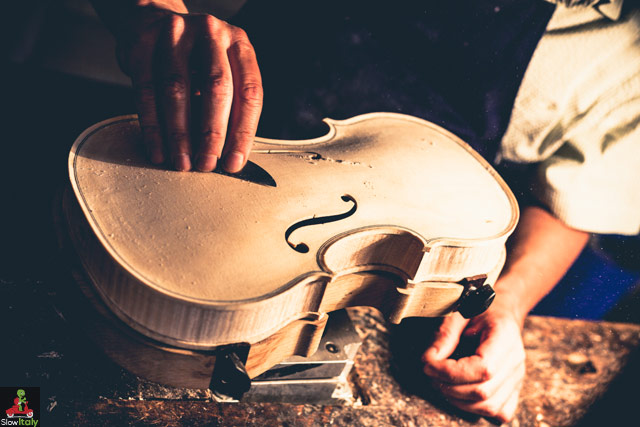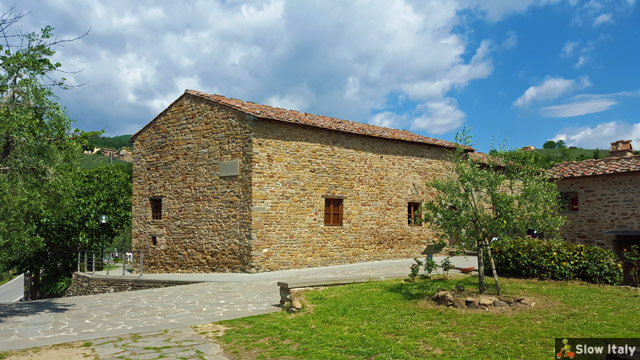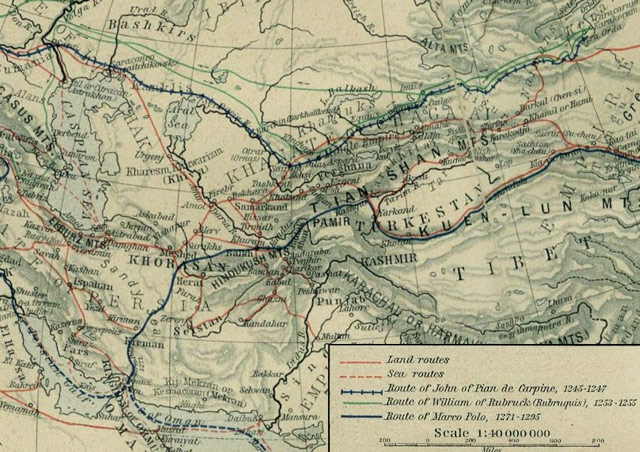Italians have made important contributions to mankind, most notably in the fields of science, mathematics, philosophy, engineering, economics, international politics, medicine, literature, visual arts and music.
In medieval Europe many of the first women scientists and physicians were Italian. See: 15 women who changed Italy.
Italians who most influenced human history
(in alphabetical order)
Andrea Amati (1500-1577)
A luthier from Cremona, Anrea Amati, laid the basis of modern violin-making. His grandson, Niccolo, had Antonio Stadivari, the inventor of the Stradivarius, as a pupil. See Italian luthiers.

Dante Alighieri (c. 1265 – 1321)
commonly known as Dante, was an Italian poet who greatly influenced generations of poets and authors throughout the centuries, such as Byron, Geoffrey Chaucer and William Blake. He was the author of La Divina Commedia (The Divine Comedy), an allegory of life and God as revealed to a pilgrim, translated into 59 different languages since 1400. It is written in terza rima, a three-line rhyme scheme of his own invention and tells the story of a man who endures the torment of Hell (Inferno) and Purgatory (Purgatorio) in his quest to reach Paradise (Paradiso).
Saint Thomas Aquinas (1225 – 1274)
Tommaso of Aquino was a medieval Catholic priest who greatly influenced thinking and teaching in philosophy. His Summa Theologica has been published in 1,317 editions in 24 different languages since 1463. His writings gave rise to several schools and periods of thomism, an encompassing synthesis of philosophy, theology and the sciences of man.
Eugenio Barsanti (1821 – 1864)
Eugenio Barsanti, together with Felice Matteuci, developed the first internal combustion engine driven by gas. Their engine was never used as a commercial device, but, as it was more economical than the previous versions, it led to groundbreaking improvements in later developments of the gas engine.
Cesare, Marquis of Beccaria (1738 – 1794)
commonly known as Cesare Beccaria was one of the first to criticize the barbarism and ad hoc nature of eighteenth century criminal justice. He is the founding father of a classical school of criminology and most criminal systems in democratic countries are directly or indirectly based upon the recommendations in his work On Crimes and Punishments.
Giambattista Beccaria (1716 – 1781)
discovered the light sensitivity of silver chloride, an important development in photography. He was also the strongest and most active supporter of Benjamin Franklin’s electrical theories.
Giovanni Boccaccio (1313 – 1375)
Boccaccio counts as an important figure in the development of a European humanist literature and influenced a large range of scholars and thinkers across genre and period.
His Decameron has been translated into 49 different languages since 1380. It is believed to have influenced Geoffrey Chaucer and his famous book of the Canterbury Tales.
Filippo Brunelleschi (1377 – 1446)
One of the most important Italian architects who designed, among other projets, the dome of the Cathedral of Florence (1419-1436) and the Sagrestia Vecchia of S. Lorenzo (1421-1440).
Michelangelo Buonarroti (1475 – 1564)
commonly known as Michelangelo, was a Renaissance painter and sculptor.
Giovanni Caboto (1450 – c. 1500)
was a Venetian navigator who explored the coast of Newfounland under the commission of Henry VII of England in 1497. His discovery made him the first European to land in North America since the Norse visits to Vinland in the eleventh century.
See: Famous Italian explorers
Tommaso Campanella (1568 – 1639)
was one of the most important philosophers of the late Renaissance. His best-known work is the utopian treatise La città del Sole (The City of the Sun). However, in reality, his thought was extremely complex and engaged with all fields of learning. He spent twenty-seven years imprisoned in Neapolitan castles (1599-1626), during which he dedicated himself to the huge task of providing a new foundation for the entire encyclopedia of knowledge.
Gerolamo Cardano (1501 – 1576)
Gerolamo Cardano was an Italian Renaissance mathematician, physician, astrologer and gambler. See: Famous Italian Mathematicians
Giosuè Carducci (1835 – 1907)
In 1906 he became the first Italian to receive the Nobel Prize in Literature. He was regarded as the official national poet of modern Italy.
See: Italian Nobel Prize Winners
Enrico Caruso (1873 – 1921)
Enrico Caruso was a famous Italian tenor who sang at the major opera houses of Europe and North and South America, appearing in a wide variety of roles from the Italian and French repertoires that ranged from the lyric to the dramatic. See also: Verismo in Italian opera.
Giovanni Caselli (1815 – 1891)
invented the pantelegraph, an ancestor of the fax, which became the first commercial application of the fax, established in 1865. For political and commercial reasons his invention was not further implemented until it was ‘re-discovered’ by the Japanese and gave rise to a widespread public use of the fax through telecom lines. See: italian inventors.
Benvenuto Cellini (1500 – 1571)
Benvenuto Cellini was an Italian goldsmith, sculptor, painter, soldier and musician, who acquired world-wide fame because of his minute and lengthy autobiography. His vivid portrayal of sixteenth-century Rome and Florence, in which drama and wit abound, is of great historical value. It was translated into German by Goethe.
Cellini’s became also famous throughout Europe for his marvelous work in precious metals.
Francesco Cirio (1836 – 1900)
Was the first to develop the concept of preserving vegetables in cans in 1856.
Christopher Columbus (1451 – 1506)
Christopher Columbus was an explorer, colonizer, and navigator from the Republic of Genoa, in northwestern Italy, whose voyages across the Atlantic Ocean led to general European awareness of the American continents in the Western Hemisphere. With his four voyages of exploration and several attempts at establishing a settlement on the island of Hispaniola, all funded by Isabella I of Castile, he initiated the process of Spanish colonization which foreshadowed general European colonization of the “New World”.
Although Columbus was not the first explorer to reach the Americas from Europe (being preceded by the Norse led by Leif Ericson), the voyages of Columbus molded the future of European colonization and encouraged European exploration of foreign lands for centuries to come.
See: Famous Italian explorers
Leonardo Da Vinci (1452 – 1519)
Leonardo di ser Piero da Vinci was an Italian polymath or the archetype of the Renaissance Man: painter, sculptor, architect, musician, scientist, mathematician, engineer, inventor, anatomist, geologist, cartographer, botanist and writer. He is widely considered to be one of the greatest painters of all time and perhaps the most diversely talented person ever to have lived. His Mona Lisa is the most famous and most parodied portrait and The Last Supper the most reproduced religious painting of all time. Leonardo is also revered for his technological ingenuity. He conceptualised a helicopter, a tank, concentrated solar power, a calculator, the double hull and outlined a rudimentary theory of plate tectonics. As a scientist, he made important discoveries in anatomy, civil engineering, optics, and hydrodynamics, but his failure to publish his findings meant that his influence on these fields is not well documented by historians. See also: Famous Italian inventors

See also: Vinci, the birthplace of Leonardo with photos of the birthhouse and birthplace of the genius artist, and a full biography of Leonardo da Vinci.
Giovanni da Pian del Carpine (c. 1185 – 1252)
John of Plano Carpini was the first European since 900 AD on record as having traveled further east than Baghdad and returned to share his observations. He was one of the first Europeans to enter the court of the Great Khan of the Mongol Empire. The account of his travels, Historia Mongalorum, show that he was a shrewd observer. They are the first European description of Mongol living conditions, customs and beliefs. See: Famous Italian explorers

Giovanni da Verrazanno (1485–1528)
Giovanni da Verrazzano greatly contributed to the science of mapmaking in terms of the geography of the East Coast of North America. The bridge spanning the Narrows between Brooklyn and Staten Island and the Jamestown Verrazzano Bridge in Rhode Island are named in honor of the explorer.
See: Famous Italian explorers
Salvino degli Armati (1258-1312)
Salvino D’Armato degli Armati of Florence is one of the possible inventors of eyeglasses. It is thought that he invented eyeglasses around 1284. See: Famous Italian inventors
Grazia Deledda (1871 – 1936)
Deledda was the first Italian woman to receive the Nobel Prize for literature. See: Italian Nobel Prize Winners
Vittorio de Sica (1901 or 1902 – 1974)
Vittorio De Sica was an Italian director and actor, a leading figure in the neorealist movement.
Federico Fellini (1920 – 1993)
Federico Fellini was an Italian film director. Known for a distinct style that blends fantasy and baroque images, he is considered one of the most influential and widely revered filmmakers of the 20th century.
Enrico Fermi (1901 – 1954)
See: Famous Italian scientists
Enzo Ferrari (1898-1988)
Italian motor racing driver andthe founder of the Ferrari and Scuderia Ferrari Grand Prix racing team. See also: Ferrari
Leonardo Fibonacci (c. 1175 – c. 1250)
Fibonacci was instrumental in popularizing Hindu-Arabic numerals in the Western world, the system we still use today (until then Roman numerals were used).See: Famous Italian Mathematicians
Tommaso Francini (1571–1651)
Garden designer and garden engineer in charge, among other projects, of the waterworks at Fontainbleau, the fountains of the Palais du Luxembourg and the Villa Medicea di Pratolino.
Dario Fò (1926 – 2016)
Nobel prize winner in literature and a relevant figure of political theatre. See: Italian Nobel Prize Winners
Galileo Galilei (1564– 1642)
Considered the “father of modern physics” and the “father of modern science”. He played a central role in the transition from natural philosophy to modern science by applying mathematics to motion. Before Galilei there as no math in physics while today’s modern physics could not be conceivable without math.
See: Famous Italian scientists
Luigi Galvani (1737 – 1798)
He is recognized as the pioneer of bioelectromagnetics. His discoveries triggered the field of neurophysiology, which in turn led to some of the greatest discoveries in neuroscience. Galvani’s name is used as a verb in everyday language (galvanize). See: Famous Italian scientists
Carlo Goldoni (1707 – 1793)
Created the Commedia dell’Arte
Cesare Lombroso (1835 – 1909)
Italian criminologist, often referred to as the father of criminology
Niccolò Machiavelli (1469 – 1527)
Recognized as the father of modern political science. His Prince has been translated into 49 languages since 1532.
Guglielmo Marconi (1874 – 1937)
Italian engineer, recipient of a Nobel Prize in physics and famous for having invented the wireless telegraphy. See: Famous Italian inventors
Antonio Meucci (1808 – 1889)
Now considered the first inventor of the telephone even if Graham Bell was the first to patent the invention. See: Famous Italian inventors
Eugenio Montale (1896 – 1981)
One of the greatest Italian lyric poets, recipient of a Nobel Prize of literature. See: Italian Nobel Prize Winners
Maria Montessori (1870 – 1952)
Italian physician and educator known worldwide for the educational method that bears her name. See: Famous Italian inventors
Luca Pacioli (c. 1447–1517)
Produced the first European text on the proper use of the number zero. His 1509 book De Divina Proportione also gave new impetus to the theory of the golden ratio by illustrating the golden ratio as applied to human faces by artists, architects, scientists, and mystics. Leonardo da Vinci took mathematics lessons from Pacioli and drew some of the illustrations for De Divina Proportione See: Famous Italian Mathematicians
Palladio (1508 – 1580)
Andrea Palladio was an Italian Renaissance architect active in the Republic of Venice. Palladio, influenced by Roman and Greek architecture, primarily by Vitruvius, is widely considered the most influential individual in the history of Western architecture. All of his buildings are located in northern Italy, but his teachings, summarized in the architectural treatise I Quattro Libri dell’Architettura (The Four Books of Architecture), gained him wide recognition.
Vilfredo Pareto (1848 – 1923)
Italian economist and sociologist. The Pareto distribution, Pareto efficiency, Pareto index and Pareto principle (also known as 80/20 rule) are named after him. See: Famous Italian scientists
Francesco Petrarca (1304 – 1374)
Francesco Petrarca (known in English as Petrarch), contemporary of Boccaccio, also known as the “Father of Humanism, was an Italian scholar, poet and one of the earliest Renaissance humanists.
Giovanni Pico della Mirandola (1463 – 1494)
Count Giovanni Pico della Mirandola was an Italian Renaissance philosopher. He is famed for the events of 1486, when at the age of 23, he proposed to defend 900 theses on religion, philosophy, natural philosophy and magic against all comers, for which he wrote the famous Oration on the Dignity of Man which has been called the “Manifesto of the Renaissance”, and a key text of Renaissance humanism.
Luigi Pirandello (1867 – 1936)
See: Italian Nobel Prize Winners
Marco Polo (c. 1254 – 1324)
Marco Polo was a merchant from the Venetian Republic who wrote Il Milione, which introduced Europeans to Central Asia and China. He learned about trading whilst his father and uncle, Niccolò and Maffeo, travelled through Asia and met Kublai Khan. In 1269, they returned to Venice to meet Marco for the first time. The three of them embarked on an epic journey to Asia, returning after 24 years to find Venice at war with Genoa; Marco was imprisoned, and dictated his stories to a cellmate.
Il Milione was translated, embellished, copied by hand and adapted; there is no authoritative version. It documents his father’s journey to meet the Kublai Khan, who asked them to become ambassadors, and communicate with the pope. This led to Marco’s quest, through Acre, into China and to the Mongol court. Marco wrote of his extensive travels throughout Asia on behalf of the Khan, and their eventual return after 15,000 miles (24,140 km) and 24 years of adventures.
Their pioneering journey inspired Columbus and others.
See: Famous Italian explorers
Giacomo Puccini (1858 – 1924)
Famous opera composer
See also: Verismo in italian opera
Salvatore Quasimodo (1901 – 1968)
One of the most important Italian poets of the 20th century. See: Italian Nobel Prize Winners
Carlo Rubbia (1934-)
See: Famous Italian scientists
Raffaello Sanzio (1483 – 1520)
Italian painter and architect known as Raffaello or Raphael, one of the leading masters of the High Renaissance. World famous for the frescoed Raphael Rooms in the Vatican Palace.
Ascanio Sobrero (1812 – 1888)
Ascanio Sobrero was cited by Alfred Nobel as the inventor of nitroglycerine. However, it was Nobel who received world-wide recognition for inventing dynamite, a stable application developed by Nobel to more easily handle and transport nitroglycerine. See: Famous Italian inventors
Altiero Spinelli (1907 – 1986)
One of the founding fathers of the European Union
Antonio Stradivari (1644-1737)
Brought the violin to its highest level of perfection. The most famous violin, the “Le Messie”, is of his makin.
Evangelista Torricelli (1608 – 1647)
A physicist and mathematician from Faenza famous for the discovery of the Torricelli’s trumpet or horn whose surface area is infinite, but whose volume is finite. The discovery prompted a fierce controversy about the nature of infinity, and is supposed by some to have led to the idea of a “completed infinity”. See: Famous Italian inventors
Antonio Maria Valsalva (1666 – 1723)
coined the term Eustachian tube and he described the aortic sinuses of Valsalva
Giuseppe Verdi (1813 – 1901)
Italian opera composer. The chorus Va, pensiero from his four acts opera Nabucco (1842) was associated with the spirit of the Italian unification movement. He is also famous for his operas, Aida, Rigoletto and La Traviata.
Amerigo Vespucci (1454 – 1512)
See: Famous Italian explorers
Luchino Visconti (1906 – 1976)
An Italian theater, opera and cinema director, best known for his films Rocco and His Brothers (1960), The Leopard (1963) and Death in Venice (1971), among others.
Alessandro Volta
Known for having invented the electric battery. See: Famous Italian inventors
Italians who most influenced the history of Italy
Camillo Benso Conte di Cavour (1810 – 1861)
Contributed to the unification of Italy
Giuseppe Garibaldi (1807 – 1882)
Contributed to the unification of Italy
Goffredo Mameli (1827 – 1849)
Composed the Italian national hymne
Alessandro Manzoni (1785 – 1873)
Wrote the first novel in Standard Italian
Vittorio Emanuele di Savoia (1820 – 1878)
First king of unified Italy
See also: Italian music
